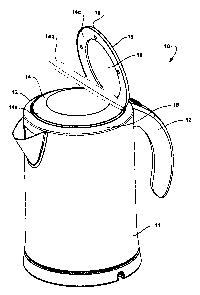Some of the information on this Web page has been provided by external sources. The Government of Canada is not responsible for the accuracy, reliability or currency of the information supplied by external sources. Users wishing to rely upon this information should consult directly with the source of the information. Content provided by external sources is not subject to official languages, privacy and accessibility requirements.
Any discrepancies in the text and image of the Claims and Abstract are due to differing posting times. Text of the Claims and Abstract are posted:
| (12) Patent: | (11) CA 2504052 |
|---|---|
| (54) English Title: | KETTLE WITH LID DAMPING MECHANISM |
| (54) French Title: | BOUILLOIRE AVEC MECANISME AMORTISSEUR DE COUVERCLE |
| Status: | Granted and Issued |
| (51) International Patent Classification (IPC): |
|
|---|---|
| (72) Inventors : |
|
| (73) Owners : |
|
| (71) Applicants : |
|
| (74) Agent: | SMART & BIGGAR LP |
| (74) Associate agent: | |
| (45) Issued: | 2013-05-28 |
| (22) Filed Date: | 2005-04-11 |
| (41) Open to Public Inspection: | 2005-10-19 |
| Examination requested: | 2010-04-06 |
| Availability of licence: | N/A |
| Dedicated to the Public: | N/A |
| (25) Language of filing: | English |
| Patent Cooperation Treaty (PCT): | No |
|---|
| (30) Application Priority Data: | ||||||
|---|---|---|---|---|---|---|
|
A vessel has a hinged lid. The hinged lid is biased into an open position by a spring. The lid is mechanically coupled to a damping mechanism, preferably concealed within the body or lid of the vessel. The lid is held in a closed position by a latch.
Récipient avec couvercle à charnière. Le couvercle à charnière est placé de biais, en position ouverte, à l'aide d'un ressort. Le couvercle est raccordé de façon mécanique à un mécanisme amortisseur, préférablement dissimulé dans le corps ou le couvercle du récipient. Le couvercle est maintenu en position fermée par un verrou.
Note: Claims are shown in the official language in which they were submitted.
Note: Descriptions are shown in the official language in which they were submitted.

2024-08-01:As part of the Next Generation Patents (NGP) transition, the Canadian Patents Database (CPD) now contains a more detailed Event History, which replicates the Event Log of our new back-office solution.
Please note that "Inactive:" events refers to events no longer in use in our new back-office solution.
For a clearer understanding of the status of the application/patent presented on this page, the site Disclaimer , as well as the definitions for Patent , Event History , Maintenance Fee and Payment History should be consulted.
| Description | Date |
|---|---|
| Common Representative Appointed | 2019-10-30 |
| Common Representative Appointed | 2019-10-30 |
| Grant by Issuance | 2013-05-28 |
| Inactive: Cover page published | 2013-05-27 |
| Inactive: Final fee received | 2013-03-18 |
| Pre-grant | 2013-03-18 |
| Notice of Allowance is Issued | 2012-10-03 |
| Letter Sent | 2012-10-03 |
| Notice of Allowance is Issued | 2012-10-03 |
| Inactive: Approved for allowance (AFA) | 2012-10-01 |
| Amendment Received - Voluntary Amendment | 2012-06-18 |
| Inactive: S.30(2) Rules - Examiner requisition | 2011-12-19 |
| Amendment Received - Voluntary Amendment | 2010-09-20 |
| Letter Sent | 2010-04-22 |
| Request for Examination Requirements Determined Compliant | 2010-04-06 |
| Request for Examination Received | 2010-04-06 |
| All Requirements for Examination Determined Compliant | 2010-04-06 |
| Inactive: IPC from MCD | 2006-03-12 |
| Inactive: IPC from MCD | 2006-03-12 |
| Inactive: IPC from MCD | 2006-03-12 |
| Application Published (Open to Public Inspection) | 2005-10-19 |
| Inactive: Cover page published | 2005-10-18 |
| Inactive: First IPC assigned | 2005-08-17 |
| Letter Sent | 2005-06-20 |
| Inactive: Single transfer | 2005-06-08 |
| Inactive: Courtesy letter - Evidence | 2005-05-24 |
| Correct Applicant Requirements Determined Compliant | 2005-05-17 |
| Filing Requirements Determined Compliant | 2005-05-17 |
| Inactive: Filing certificate - No RFE (English) | 2005-05-17 |
| Application Received - Regular National | 2005-05-16 |
There is no abandonment history.
The last payment was received on 2013-03-18
Note : If the full payment has not been received on or before the date indicated, a further fee may be required which may be one of the following
Please refer to the CIPO Patent Fees web page to see all current fee amounts.
Note: Records showing the ownership history in alphabetical order.
| Current Owners on Record |
|---|
| BREVILLE PTY. LTD. |
| Past Owners on Record |
|---|
| GERARD WHITE |